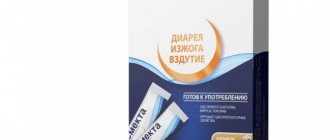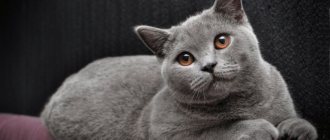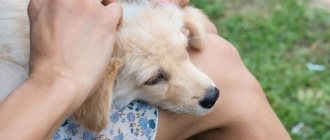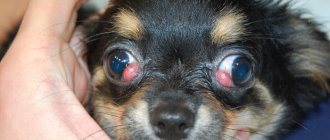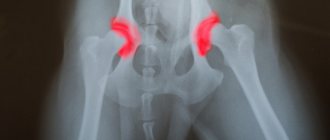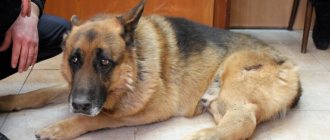What it is
Dermatophytosis in dogs goes away without treatment in a few weeks or months, if there are no health problems. But during this time, your four-legged friend can infect other animals and people, and skin problems can cause discomfort. Ringworm responds well to treatment, so it is better not to delay treatment, but to immediately rid your pet of fungal dependents. Correct actions will shorten the duration of the disease and prevent complications.
There are more than 30 types of fungal microorganisms. Dogs are affected in 70% of cases by Microsporum canis. The remaining pathogens are usually transmitted to them from other animals - cats, mice, rats, cows, horses, etc.
Dermatophytosis is the general name for a group of diseases. They differ in pathogen, symptoms, and treatment. The following types are common among dogs:
- ringworm;
- trichophytosis;
- microsporia;
- favus (scab).
Each fungus requires exposure to certain medications, so you should not try to recognize the disease on your own. If you treat your pet incorrectly, dermatophytosis will drag on and the pet will weaken. Microorganisms will feel freer, and the disease will worsen.
Treatment of ringworm in dogs
Treatment of dermatomycosis in dogs can be vaccination or medication. Both methods are effective. The choice of one or another method of treatment depends on the condition of the pet and whether it has contraindications to taking or intramuscularly administering certain drugs.
Vaccines
Vaccines are not only an effective means of combating this disease, but also a good preventative measure that helps prevent its occurrence in your pet.
Among the drugs that help cope with fungal infections, the most popular and those that have the most rapid and effective effect are:
- "Vakderm". This yellowish-brown drug is administered to the animal intramuscularly twice. The first time - in one limb, the second time - in the other. The interval between the first and second administration of the vaccine is from 10 to 14 days. As for the dosage, it does not differ depending on the purpose of such intramuscular intervention - treatment or prevention. For dogs that weigh less than 5 kg, the dose of the drug is 0.5 ml, and for pets whose weight exceeds 5 kg - 1 ml.
- "Polivak-TM". The medicine has a light brown tint. When storing the drug, sediment accumulates in it, so before drawing it into a syringe, the ampoule must be shaken so that the sediment dissolves. If the vaccine is administered for the purpose of treating dermatomycosis, then this procedure must be repeated 3 times with an interval between each administration of 10-14 days. Dosage - 0.5-0.6 ml. If the purpose of using the drug is prevention, two injections should be given at the same interval. In this case, a single dose of the drug should be no more than 0.3 ml.
Important! Such injections should not be given to pets with a high temperature.
- Microderm. On pharmacy shelves or in veterinary stores, this drug can be found in two forms: dry (in the form of a gray-yellow porous mass that requires separate manipulations so that it can be administered intramuscularly) and liquid (a solution ready for use). If you purchased the vaccine in dry form, it must be mixed with saline or distilled water in the following proportions: 1 ml of liquid per dose of the drug. Detailed instructions for use should be indicated on the packaging or prescribed by a veterinarian. To use the vaccine in liquid form, simply shake the bottle with the drug. Microderm is administered twice only if the pet’s symptoms of the disease have not disappeared within 10-14 days after the first use. The dosage depends on the age and weight of the animal - puppies are usually administered from 0.5 ml to 1 ml, and adult pets - from 1 to 2 ml.
Do not be afraid of the ball that may appear after the injection of one of the above vaccines at the injection site: it will resolve within a few days after the procedure.
Antibiotics
As a rule, treatment with antibiotics is prescribed if there are contraindications to administering vaccines to the dog. Recommended drugs in tablets for the treatment of dermatomycosis in animals:
- "Griseofulvin" (such tablets should be used with caution due to their toxicity);
- Nizoral/ketoconazole (have almost identical composition and the same active ingredient);
- Itraconazole
The duration of treatment with antibiotics and their dosage are prescribed by a veterinarian, depending on the symptoms and stage of development of the disease.
In the case of drug treatment, it is necessary to treat the skin externally with antifungal ointments (clotrimazole, ketoconazole, nystatin, etc.). It is also recommended to trim the fur around the affected areas. If the dog has long hair and there are many places affected by the fungus on its body, paws and face, it is better to shave it completely.
Deep dermatomycosis also involves washing animals with special shampoos.
Quite often, to combat this disease, doctors prescribe a course of treatment (from 10 to 15 sessions) using a quartz lamp (UVR). Such procedures involve exposing damaged parts of the skin to a lamp and initially last about 30 seconds. With each subsequent session, the duration of the procedure increases and at the end it is 2 minutes.
Important! During such procedures, protect your pet's eyes from exposure to lamp light.
Symptoms and signs
The disease does not manifest itself immediately; after infection, it takes from 3 days to 3 months before the first symptoms appear. First, the pathogen enters the animal’s skin and releases toxins and enzymes that cause peeling of the skin. At this stage, dermatophytosis is invisible.
The fungus then invades the hair follicles and destroys them, causing hair to fall out. Horny scales and dried pus become visible on the skin. At first it is noticeable only in a small area, then it grows and gives rise to new lesions.
If the pathogen penetrates the skin, it will cause deep inflammation, and the accumulating pus will form an abscess. Hard bumps will appear in place of the fallen fur. If you press on them, it will hurt your pet.
The first patches of baldness usually appear on the face - around the eyes and ears. Hair loss is possible on the paws or withers. The rate of spread of bald spots is influenced by the type of pathogen, the immunity of the animal, and the conditions of its detention.
The coat undergoes changes throughout the body. At first, she looks normal, even if patches of baldness have already formed. Then the hairs become dull, become brittle, and fall out more often. The fur appears to be dirty and matted. Some owners think that poor quality food or infrequent bathing is to blame, so they delay treatment.
Some types of dermatophytosis cause itching. Usually it is weak - the pet itches a little more often than usual, without much diligence. Basically, he tries to catch the bald areas. It’s worse if the animal scratches the skin furiously until it bleeds. A secondary infection gets into the wounds, and the weakened immune system can no longer cope with it.
In general, the dog behaves as usual, the appetite remains the same. Only if dermatophytosis is complicated by an abscess or severe itching does the animal refuse food and water and become apathetic.
Is it dangerous for humans?
Dermatophytosis is also transmitted to humans. You can get infected from your own or a street dog and from other people. Children are more at risk because they often come into contact with animals without following safety rules. The peak incidence occurs during the summer holidays, when children spend a lot of time outside without adults and play with street animals.
Usually the fungus spreads under the hair on the head, the lesion grows to the size of the palm of your hand. Lesions also form on the body, most often on the arms, stomach and back. Symptoms of dermatophytosis are the same in humans and dogs.
First, a pink spot appears on the skin, then it grows, and a white raised ridge forms along the edges. In the middle, the skin peels off, the hair becomes brittle and falls out. Sometimes there is a slight itching.
In adults, dermatophytosis is the second most common skin disease after foot fungus. With age, the body becomes less vulnerable to this disease, since the hair produces substances that inhibit the activity of spores that land on the skin. Young girls are more susceptible to the disease. Interestingly, lichen rarely develops in people with red hair.
The likelihood of contracting dermatophytosis increases with reduced immunity. Pregnant women and patients who have had an infectious disease or surgery are at risk. Exacerbation of chronic diseases also reduces the body's defense response.
Ringworm in cats and dogs
Dermatophytes are a type of pathogenic fungi that cause damage to the superficial layers of the skin and other keratinized tissues, such as claws and fur.
There are 3 types of dermatophytes that cause lesions in small animals: 1. Microsporum canis 2. Microsporum gypseum 3. Trichophiton mentagrophytes.
Microsporum canis is the most common cause of dermatophytosis in cats and dogs. This dermaophyte can live on the skin and fur, and can also live for a long period of time in the environment (up to 18 months!) Some animals are carriers without clinically showing symptoms, but they can become a source of infection for other animals and humans.
Microsporum gypseum lives in the soil. The risk groups for infection with this dermatophyte are dogs that burrow in the ground and hunting dogs. Trichophiton mentagrophytes is most often transmitted by rodents.
The spread of the disease depends on the climate and lifestyle of the animal. Thus, in warm and humid climates, infection occurs more often; animals in large groups (shelters, nurseries) that hunt rodents are predisposed to this disease. There are also genetically predisposed breeds - Yorkshire terrier, Himalayan and Persian cats.
Dermatophytes pose a danger to people because they can be transmitted to humans, especially to people with reduced immunity, the elderly and children.
Clinical signs may vary. The classic symptoms are circular alopecia (bald patches) with a red edge and covered with gray scales. Most often there is no itching. But there may be inflammatory reactions, itching, scabs (crusts), and rash. Most often, symptoms begin to appear on the head and paws, and as the disease progresses, it can affect the entire body. Sometimes a localized lesion occurs - a kerion is a nodular lesion that appears as a result of the body's immune response to the invasion of dermatophytes. Some animals, especially cats, can be asymptomatic carriers.
The diagnosis can be difficult to establish, as there may be no specific signs and dermatophytosis can mimic other skin diseases. There are express diagnostic methods - examination with a Wood's lamp (50% reliability), hair microscopy (40-70% accuracy). A more reliable method is to sow wool on nutrient media. In some cases, skin histology is required to make a definitive diagnosis. If there is a glow under a lamp, the diagnosis must be confirmed by detecting spores under a microscope or by culture.
Treatment depends on the severity of the disease, the age of the animal, living conditions and concomitant diseases. In young healthy animals, the disease can resolve on its own, but in most cases aggressive treatment is required, including to reduce the risk of infection to humans. Treatment is almost always local and systemic. Environmental treatment is required to reduce the risk of re-infection.
Confirmation of the animal's recovery is possible only upon receipt of 2 negative culture results with an interval of 1 month. Re-infection from the environment is common. Be patient! Treatment may take several months. Particularly difficult are nurseries and shelters, where it is almost impossible to isolate the pathogen and eliminate environmental contamination.
To prevent dermatophytosis in your pets, you should follow the conditions of keeping and feeding the animals, disinfect the premises, avoid large gatherings of animals, and exclude contact with wild and stray animals, as well as rodents.
Head of the department of therapy, dermatologist, Romashova I.V.
Treatment options
To treat dermatophytosis, you need to consult a veterinarian, since an unknowing person may confuse the disease with other skin lesions. The doctor will examine the pet and analyze the appearance of the fur under the light of a Wood's lamp - a device that illuminates fungi in green. If this is not enough, blood and urine tests are prescribed.
Vaccines
At an early stage of the disease, vaccines against dermatophytosis are used. They eliminate small foci of lichen and protect the animal’s body from re-infection for 1 year. The preparation contains small doses of different types of fungi. After their administration, immunity to the effects of the pathogen develops.
The injection is given in the thigh area. The veterinarian selects a drug from 6 options - Mikkanis, Vakderm, Vakderm-F, Microderm, Multikan-7 and Polivac-TM. Dermatophytosis disappears after the second injection, and less often a third is required.
Systemic therapy for severe cases
In all cases where the course of the disease is severe, or there is a tendency for the process to worsen, treatment of dermatophytosis in dogs should be systemic. For this, itraconazole, fluconazole, terbinafine, ketoconazole and antibiotics from the griseofulvin group are used.
As for the latter, it is recommended to use them daily for dogs, at a dose of 25-100 mg/kg. This dose can be divided into several doses, or given once. If antibiotics are used not in injection form, but in the form of tablets for oral administration, then they are given simultaneously with fatty food (for better absorption and minimizing the harmful effects on the gastrointestinal tract).
It is very important to accurately maintain the dosage and vary it depending on the weight and physiological state of the sick animal. Medicinal griseofulvins are also well suited for use in veterinary medicine.
If they are used for too long, neutropenia and other reactions from the hematopoietic system may develop. Cases have also been described in which long-term use of these antibiotics may have led to the development of leukemia. However, there is little information about this, but the fact remains that you should not uncontrollably “stuff” your pet with antifungal drugs, as this can end very badly!
Other effective treatments include itraconazole 5-10 mg/kg per day for 28 days. The drug can also be used courses , when the animal is given the medicine for 7 days, and for the next seven days its body “rests” from its effects. The following have proven themselves to be effective: ketoconazole (5-10 mg/kg per day), terbinafine (30-40 mg/kg per day), fluconazole (5-10 mg/kg per day). The latter, by the way, is used only in the mildest cases, since studies show its low effectiveness against most pathogenic fungi.
It is believed that terbinafine is most effective for many dermatophytoses. After just two weeks of use, clear signs of improvement are often visible, after which the dose of the medicine can be reduced (at the discretion of the veterinarian). But with this drug everything is not so simple, there are side effects. In particular, it often leads to the development of anorexia (the dog does not eat anything), and in some cases the animal has to be fed for a very long time either through a gastric tube, or kept alive by infusing nutrient solutions intravenously.
Prevention measures
It is impossible to completely protect your pet from lichen. The dog is always in contact with the environment, which may contain particles of fungal microorganisms. The owner can only reduce the risk of dermatophytosis if he follows the following rules:
- do not allow your dog to come into contact with street animals;
- feed the animal a balanced diet;
- treat all other diseases in a timely manner;
- visit the veterinarian regularly, even if the dog is not bothered;
- bathe the animal with antifungal agents, but without fanaticism - too frequent water procedures weaken the protective functions of the skin.
Preventive measures are mandatory in animal shelters and foster care facilities. If one dog becomes infected, dermatophytosis will quickly spread to all the others.
Ringworm in dogs
Small bald patches on your pet's fur may be the result of dermatomycosis. Dermatomycosis is a ringworm that is dangerous for animals and people with weakened immune systems.
The article gives a general idea of how such a problem is dealt with in a veterinary clinic and what is done to make an accurate diagnosis. If we talk about the choice of treatment and accurate diagnosis, then this will be impossible on the Internet, but possible when visiting a veterinarian.
What is dermatomycosis in dogs, symptoms, vaccines, how and what to treat, symptoms, signs, how it begins and how to determine it, incubation period
Dermatomycosis is a disease that affects the fur, skin and claws of an animal. Most often, it affects puppies whose immune systems have not yet been formed or weakened animals. The stimulus for the development of the disease can be a lack of certain nutrients, stress, or a viral or parasitic infection.
The incubation period lasts about three weeks. A sign of the disease is the appearance of “bald patches” on the fur.
Prayers
In bare areas, the animal's skin begins to peel off and turn red. To correctly establish a diagnosis, the clinic examines the animal’s claws and hair for the presence of fungus.
Ringworm in dogs treatment with tar, medicines, ointment, spray, injections
When treating this disease, it is necessary to use immunostimulants. If the lesions are large, the hair is cut and burned, and the animal is washed with antifungal shampoo.
They use Polivac, Microderm, etc. vaccines for prevention and treatment, giving two injections with a two-week break. Wash the affected areas with Nizoral, treat with Lamisil spray and Clotrimazole ointment. For extensive lesions, the doctor may prescribe the antibiotic Grisiofulvin.
Treatment with tar may be ineffective. Tar soap is best used for prevention when washing hands after contact with a sick animal.
Dermatomycosis in dogs: is it ringworm or not, the pathogen is treated at home, celandine, prognosis and prevention
The causative agent of this disease is dermatophyte spores. This is ringworm, a fungal infection. It is contagious to humans, so the movement of a sick animal around the apartment must be limited. It is better to treat the room with a quartz lamp.
It is necessary to treat the disease at home under the supervision of a doctor. For treatment, it is better to use effective antifungal drugs, rather than celandine, iodine and vegetable oil. Since dermatomycosis is quite contagious, if the animal is treated for a long time, the whole family can get shingles.
The prognosis for treatment, even in very advanced cases, is always favorable. For prevention, it is necessary to strengthen the immune system, get vaccinated against dermatomycosis, and prevent the animal from coming into contact with stray and sick dogs.
Is ringworm in dogs and cats transmitted (contagious) to humans or not, how dangerous is it?
Canine and feline ringworm is contagious. This disease is more unpleasant than dangerous. It is better to handle a sick animal using rubber gloves, which must then be thrown away.
Ringworm in dogs on the nose, paw, muzzle, tail, initial stage
The disease begins with the appearance of small rashes on the skin. The dog is constantly itching, which is difficult not to notice. Then the rashes increase in size, the skin becomes inflamed, reddens, and crusts over. The hair begins to fall out. If treatment is not started, purulent inflammation may appear on the affected areas of the skin.




